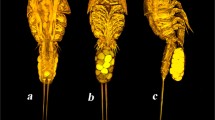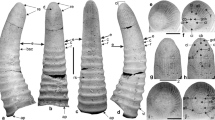Abstract
The copepodite antennule development of several harpacticoid families is studied and male antennule development of 5 species is schematically illustrated. The origin of newly formed segments can be determined by seta numbers of segments, relative segment length, furrows indicating previous articulations and by the position of the segment which bears the proximal aesthetasc. At least in some species sexual dimorphism of antennules is present from C II onwards. Females practically reach the adult antennular stale at C V whereas males undergo drastic changes from C V to C VI with proximal addition of segments, and often with distal fusions and formation of a unique armature due to functional adaptations in clasping behaviour. No correlation has been found between clasping mode, male antennule type and taxonomic level. In closely related species of the same genus both chirocer and subchirocer antennules are found. The postnaupliar development of the chirocer type can proceed along different ways. Consequently it is suggested that at least chirocer antennules have originated several times independently during harpacticoid evolution.
Access this chapter
Tax calculation will be finalised at checkout
Purchases are for personal use only
Preview
Unable to display preview. Download preview PDF.
Similar content being viewed by others
References
Abraham, S. & U. K.Gopalan, 1975. Growth of an estuarine harpacticoid copepod Nitocra spinipes Boeck cultured in the laboratory. Bull. Dep. mar. Sci. Univ Cochin 7: 309–318.
Boxshall, G. A., F. D. Ferrari &H. Tiemann, 1984. The ancestral copepod: towards a consensus of opinion at the First International Conference on Conference on Copepada. Crustaceana Suppl. 7: 68–84.
Bozic, B., 1975. Aktometrische Entdeckung eines interattracktiven Faktors bei Tigriopus (Crust., Copepoda, Harpacticoida). Bull. Soc. zool Fr 100: 305–311.
Dahms, H.-U, 1985. Zur Harpacticidenfauna der Jade innerer Teil) im Tidebereich. Drosera 85: 65–76.
Dahms, H.-U., 1986 Zur Biologie von Paramphiascella fulvofasciata (Copepoda, Harpacticoida) Helgoländer wiss. Meeresunters. 40: 267–277.
Dahms, H.-U., 1987. Postembryonic development of Drescheriella glacialis Dahms AND (amp) Dieckmann, 1987 (Copepoda, Harpacticoida) reared in the laboratory, Polar Biol. 8: 81–93.
Itô, T., 1971. The biology of a harpacticoid copepod, Harpacticus uniremis Kröyer. J. Fac. Sci. Hokkaido Univ., Ser. 6, 18: 235–255.
Itô, T. & J.J.S. Burton, 1980. A new genus and species of the family Canthocamptidae (Copepoda, Harpacticoida) from a hot spring at Dusun Tua, Selangor, Malaysia.Zool.Jb. 107: 1–31
Itô, T. & T. Takaxhio, 1981. The larval development of Canthocamptus mirabilis Sterba (Copepoda. Harpacticoida). with reference to the bionomics J. Fac. Sci. Hokkaido Univ., Ser. 6, Zool. 22(3): 279–300.
Kern, J.C., N.A. Edwards & S.S. Bell, 1984. Precocious clasping of early copepodite stages: a common occurrence in Zausodes arenicolux Wilson (Copepoda, Harpacticidengenera). J. crust. Biol 4 (2): 261–265.
Lang, K. 1935. Über Umfang und systematische Stellung einiger Harpacticidengenera. Kungl. Fysiogr. Sällsk. Lund Förh. 5 (21): 209–216.
Lang, K., 1948. Monographie der Harpacticiden I und II. Reprint 1975. O. Koeltz Science Publishers, Koenigstein, West Germany 1682 S.
Strickler, R., 1973. Setae of the first antennae of the copepod Cyclops scutifer (Sars). Their structure and importance. Proc natl. Acad. Sci. USA 70: 2656–2659.
Vincx, M. & C. Heip, 1979. Larval development and biology of Canuella perplexa T. and A. Scott, 1893 (Copepoda, Harpacticoida). Cah. Biol. mar. 20: 281–299.
Author information
Authors and Affiliations
Editor information
Rights and permissions
Copyright information
© 1988 Kluwer Academic Publishers
About this paper
Cite this paper
Dahms, HU. (1988). Development of functional adaptation to clasping behaviour in harpacticoid copepods (Copepoda, Harpacticoida). In: Boxshall, G.A., Schminke, H.K. (eds) Biology of Copepods. Developments in Hydrobiology, vol 47. Springer, Dordrecht. https://doi.org/10.1007/978-94-009-3103-9_57
Download citation
DOI: https://doi.org/10.1007/978-94-009-3103-9_57
Publisher Name: Springer, Dordrecht
Print ISBN: 978-94-010-7895-5
Online ISBN: 978-94-009-3103-9
eBook Packages: Springer Book Archive




